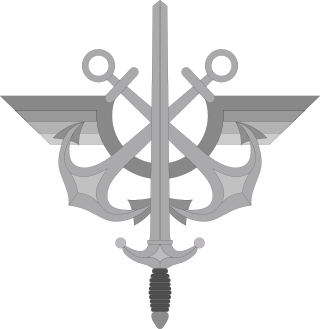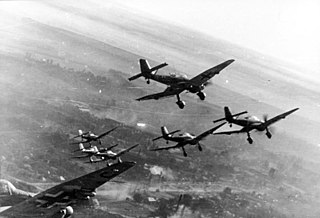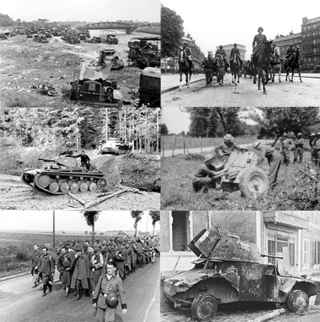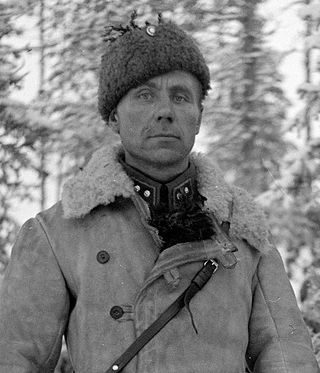| |||||
| Decades: | |||||
|---|---|---|---|---|---|
| See also: | Other events of 1436 History of France • Timeline • Years | ||||
Events from the year 1436 in France
| |||||
| Decades: | |||||
|---|---|---|---|---|---|
| See also: | Other events of 1436 History of France • Timeline • Years | ||||
Events from the year 1436 in France

The French Armed Forces encompass the Army, the Navy, the Air and Space Force and the Gendarmerie of the French Republic. The President of France heads the armed forces as Chief of the Armed Forces.

World War II or the Second World War, often abbreviated as WWII or WW2, was a global conflict that lasted from 1939 to 1945. The vast majority of the world's countries, including all of the great powers, fought as part of two opposing military alliances: the Allies and the Axis. Many participants threw their economic, industrial, and scientific capabilities behind this total war, blurring the distinction between civilian and military resources. Aircraft played a major role, enabling the strategic bombing of population centres and the delivery of the only two nuclear weapons ever used in war.

The French and Indian War (1754–1763) was a theater of the Seven Years' War, which pitted the North American colonies of the British Empire against those of the French, each side being supported by various Native American tribes. At the start of the war, the French colonies had a population of roughly 60,000 settlers, compared with 2 million in the British colonies. The outnumbered French particularly depended on their native allies.

The Axis powers, originally called the Rome–Berlin Axis, was a military coalition that initiated World War II and fought against the Allies. Its principal members were Nazi Germany, the Kingdom of Italy, and the Empire of Japan. The Axis were united in their opposition to the Allies, but otherwise lacked comparable coordination and ideological cohesion.

The Napoleonic Wars (1803–1815) were a series of conflicts fought between the First French Empire under Napoleon (1804–1815), and a fluctuating array of European coalitions. The wars originated in political forces arising from the French Revolution (1789–1799) and from the French Revolutionary Wars (1792–1802), and produced a period of French domination of Continental Europe. There were seven Napoleonic Wars, five named after the coalitions that fought Napoleon, plus two named for their respective theatres: (i) the War of the Third Coalition (1803–1806), (ii) the War of the Fourth Coalition (1806–1807), (iii) the War of the Fifth Coalition (1809), (iv) the War of the Sixth Coalition (1813–1814), (v) the War of the Seventh Coalition (1815), (vi) the Peninsular War (1807–1814), and (vii) the French invasion of Russia (1812). They were the most widespread and costly wars in European history before World War I.

Napoleon Bonaparte, later known by his regnal name Napoleon I, was a French military commander and political leader who rose to prominence during the French Revolution and led successful campaigns during the Revolutionary Wars. He was the de facto leader of the French Republic as First Consul from 1799 to 1804, then Emperor of the French from 1804 until 1814 and again in 1815. Napoleon's political and cultural legacy endures to this day, as a highly celebrated and controversial leader. He initiated many liberal reforms that have persisted in society, and is considered one of the greatest military commanders in history. His wars and campaigns are studied by militaries all over the world. Between three and six million civilians and soldiers perished in what became known as the Napoleonic Wars.

Operation Torch was an Allied invasion of French North Africa during the Second World War. Torch was a compromise operation that met the British objective of securing victory in North Africa while allowing American armed forces the opportunity to engage in the fight against Nazi Germany on a limited scale. It was the first mass involvement of US troops in the European–North African Theatre, and saw the first major airborne assault carried out by the United States.

Free France was a political entity that claimed to be the legitimate government of France following the dissolution of the Third Republic. Led by French general Charles de Gaulle, Free France was established as a government-in-exile in London in June 1940 after the Fall of France during World War II and fought the Axis as an Allied nation with its Free French Forces. Free France also supported the resistance in Nazi-occupied France, known as the French Forces of the Interior, and gained strategic footholds in several French colonies in Africa.
A lieutenant is a commissioned officer rank in the armed forces of many nations.
Brigadier general or Brigade general is a military rank used in many countries. The rank is usually above a colonel, and below a major general or divisional general. When appointed to a field command, a brigadier general is typically in command of a brigade consisting of around 4,000 troops.

The Battle of France, also known as the Western Campaign, the French Campaign and the Fall of France, was the German invasion of France during the Second World War.

Operation Dragoon was the code name for the landing operation of the Allied invasion of Provence on 15 August 1944. Although initially designed to be executed in conjunction with Operation Overlord, the Allied landing in Normandy, a lack of available resources led to a cancellation of the second landing. By July 1944 the landing was reconsidered, as the clogged-up ports in Normandy did not have the capacity to adequately supply the Allied forces. Concurrently, the High Command of the French Liberation Army pushed for a revival of the operation that would include large numbers of French troops. As a result, the operation was finally approved in July to be executed in August.

A gendarmerie is a military force with law enforcement duties among the civilian population. The term gendarme is derived from the medieval French expression gens d'armes, which translates to "rural police" or "men-at-arms". In France and some Francophone nations, the gendarmerie is a branch of the armed forces that is responsible for internal security in parts of the territory, with additional duties as military police for the armed forces. It was introduced to several other Western European countries during the Napoleonic conquests. In the mid-twentieth century, a number of former French mandates and colonial possessions adopted a gendarmerie after independence. A similar concept exists in Eastern Europe in the form of Internal Troops, which are present in many countries of the former Soviet Union and its former allied countries.

The European theatre of World War II was one of the two main theatres of combat during World War II. It saw heavy fighting across Europe for almost six years, starting with Germany's invasion of Poland on 1 September 1939 and ending with the Western Allies conquering most of Western Europe, the Soviet Union conquering most of Eastern Europe and Germany's unconditional surrender on 8 May 1945 although fighting continued elsewhere in Europe until 25 May. On 5 June 1945, the Berlin Declaration proclaiming the unconditional surrender of Germany to the four victorious powers was signed. The Allied powers fought the Axis powers on two major fronts as well as in a strategic bombing offensive and in the adjoining Mediterranean and Middle East theatre.

The French Navy, informally La Royale, is the maritime arm of the French Armed Forces and one of the five military service branches of France. It is among the largest and most powerful naval forces in the world, ranking seventh in combined fleet tonnage and fifth in number of naval vessels. The French Navy is one of eight naval forces currently operating fixed-wing aircraft carriers, with its flagship Charles de Gaulle being the only nuclear-powered aircraft carrier outside the United States Navy, and one of two non-American vessels to use catapults to launch aircraft.

The North African campaign of the Second World War took place in North Africa from 10 June 1940 to 13 May 1943. It included campaigns fought in the Libyan and Egyptian deserts and in Morocco and Algeria, as well as Tunisia.

The Mediterranean and Middle East Theatre was a major theatre of operations during the Second World War. The vast size of the Mediterranean and Middle East theatre saw interconnected naval, land, and air campaigns fought for control of the Mediterranean, North Africa, the Horn of Africa, the Middle East and Southern Europe. The fighting in this theatre lasted from 10 June 1940, when Italy entered the war on the side of Germany, until 2 May 1945 when all Axis forces in Italy surrendered. However, fighting would continue in Greece – where British troops had been dispatched to aid the Greek government – during the early stages of the Greek Civil War.

The Allies, formally referred to as the United Nations from 1942, were an international military coalition formed during the Second World War (1939–1945) to oppose the Axis powers, led by Nazi Germany, Imperial Japan, and Fascist Italy. Its principal members by the end of 1941 were the United Kingdom, United States, Soviet Union, and China.

The army rank of captain is a commissioned officer rank historically corresponding to the command of a company of soldiers. The rank is also used by some air forces and marine forces, but usually refers to a more senior officer. Today, a captain is typically either the commander or second-in-command of a company or artillery battery. In the Chinese People's Liberation Army, a captain may also command a company, or be the second-in-command of a battalion.

Vichy France, officially the French State, was the French state headed by Marshal Philippe Pétain during World War II. Officially independent, but with half of its territory occupied under the harsh terms of the armistice with Nazi Germany, it adopted a policy of collaboration. The Occupation of France by Nazi Germany at first affected only the northern and western portions of the country, before the Germans occupied the remainder of Metropolitan France in November 1942. Though Paris was ostensibly its capital, the Vichy government established itself in the resort town of Vichy in the unoccupied "Free Zone", where it remained responsible for the civil administration of France as well as its colonies.